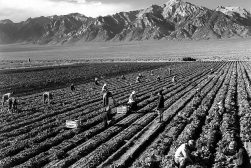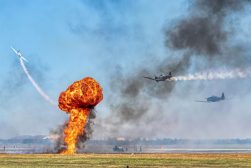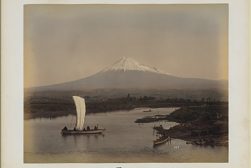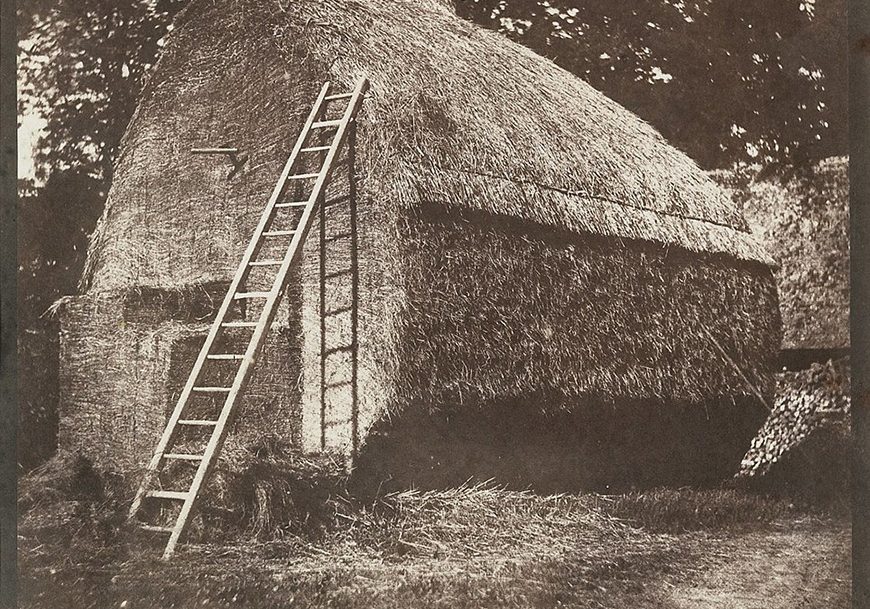
43 Famous British Photographers You Should Know
Discover the diverse and multifaceted approaches that British photographers have taken, creating a rich tapestry of photographic expression and innovation.
The world of photography has been greatly influenced by the creative talents of British photographers.
From capturing iconic moments in history to exploring the subtle beauty of everyday life, these artists have left an indelible mark on the medium.
Through their distinctive vision and technical prowess, they have shaped the course of photography and inspired generations of aspiring photographers.
This article highlights some of the most famous British photographers, their groundbreaking work, and the impact they have made on the art form.
From the pioneers of early photography to contemporary visionaries, each photographer’s unique style and artistic contributions have contributed to the rich tapestry of the UK’s photographic history.
Join us on a journey through the lens of these remarkable men and women, as we delve into their captivating images and delve into the stories behind their iconic photographs.
- American Photographers
- Japanese Photographers
- Australian Photographers
- Chinese Photographers
- French Photographers
Table of Contents
43 British Photographers To Follow in 2023
David Hockney
David Hockney is a British artist known for his contributions to pop art and his exploration of photography as an artistic medium.
Born in 1937, Hockney gained recognition for his vibrant and colorful paintings, but he also delved into photography, experimenting with techniques such as photo collages and joiners.
His “joiner” works, created by assembling multiple Polaroid or 35mm photographs into a composite image, showcased his unique vision and approach to capturing space and time.
Hockney’s photography work often explores landscapes, portraits, and everyday scenes, demonstrating his ability to blend artistic expression with the photographic medium.
Rankin
View this post on Instagram
Rankin is a British photographer known for his impactful and provocative fashion and portrait photography.
Born John Rankin Waddell in 1966, Rankin co-founded the fashion magazine Dazed & Confused and gained recognition for his distinct visual style.
His photographs have graced the covers of numerous magazines and he has captured portraits of various celebrities, including Kate Moss, Madonna, and Queen Elizabeth II.
Rankin’s photographs often challenge conventional beauty standards and push the boundaries of fashion and portraiture, resulting in striking and thought-provoking images.
Nick Knight
Nick Knight is a British fashion photographer known for his innovative and avant-garde approach to the genre.
Born in 1958, Knight’s work has been featured in major fashion publications and he has collaborated with renowned designers and artists.
His photography often pushes the boundaries of technology and explores the intersection of fashion, art, and culture.
Knight’s notable works include his collaborations with designer Alexander McQueen and his influential fashion film “To Lee, With Love, Nick,” paying tribute to the late designer.
His experimental and visually captivating photography has made a significant impact on the fashion industry.
David Bailey
View this post on Instagram
David Bailey is a British photographer known for his influential fashion and portrait photography.
Born in 1938, Bailey rose to fame in the 1960s and became one of the most sought-after photographers of the era.
His iconic portraits of celebrities, musicians, and models captured the spirit of the Swinging Sixties and helped define the cultural and fashion landscape of the time.
Bailey’s ability to capture the essence and personality of his subjects, combined with his striking compositions, has made him a revered figure in the world of photography.
Throughout his career, Bailey has continued to push boundaries and remains an influential and respected photographer.
Andy Goldsworthy
Andy Goldsworthy is a British artist known for his site-specific sculptures and environmental artwork.
Born in 1956, Goldsworthy often incorporates photography into his artistic process, documenting his ephemeral and nature-based installations.
His photographs capture the temporary beauty and transformation of natural materials, such as leaves, stones, and ice, as they interact with their surroundings.
Goldsworthy’s work explores the relationship between nature and human intervention, often highlighting the fragility and impermanence of the natural world.
His photographs serve as a record of his intricate and transient creations, inspiring viewers to contemplate the beauty and interconnectedness of the environment.
Patrick Anson, 5th Earl of Lichfield
Patrick Anson, better known as Lord Lichfield, was a British photographer and member of the royal family.
Born in 1939, Lord Lichfield gained fame for his glamorous and elegant portrait photography.
He photographed numerous celebrities, including the British royal family, and his work was featured in prestigious publications.
Lord Lichfield’s iconic photographs captured the essence of the people he photographed, combining a regal sense of composition with a relaxed and intimate approach.
His legacy as a photographer and his connections to the royal family established him as an influential figure in the world of portrait photography.
Antony Armstrong-Jones
Antony Armstrong-Jones, also known as Lord Snowdon, was a British photographer and filmmaker.
Born in 1930, Lord Snowdon became known for his striking portraits of celebrities, politicians, and members of the British royal family.
His photographs captured the personality and individuality of his subjects, showcasing his keen eye for composition and his ability to establish a connection with the people he photographed.
Lord Snowdon’s work extended beyond portraiture, as he documented diverse subjects, including social issues and the arts.
His innovative approach to photography and his contributions to the medium earned him international recognition and made him a prominent figure in British photography.
Martin Parr
View this post on Instagram
Martin Parr is a British documentary and portrait photographer known for his satirical and humorous approach to capturing everyday life.
Born in 1952, Parr’s photography often highlights the idiosyncrasies and eccentricities of British culture and society.
His series “The Last Resort” captured the vibrant and often kitschy atmosphere of British seaside resorts, while his project “Common Sense” explored consumer culture and mass tourism.
Parr’s use of vibrant colors and exaggerated compositions adds a distinctive and playful quality to his work, challenging traditional documentary conventions.
His photographs are a witty and often critical commentary on contemporary society, making him one of the most recognizable and influential British photographers of his generation.
Tim Walker
Tim Walker is a British fashion photographer known for his fantastical and dreamlike imagery.
Born in 1970, Walker’s photographs transport viewers into whimsical and otherworldly realms.
His imaginative and elaborate fashion shoots have been featured in prominent publications, and he has collaborated with renowned designers and stylists.
Walker’s work often combines storytelling, theatricality, and intricate sets, creating visually captivating and surreal narratives.
His photographs evoke a sense of wonder and invite viewers to immerse themselves in a world of fantasy and imagination.
Cecil Beaton
Cecil Beaton was a British photographer and designer known for his elegant and glamorous portraits.
Born in 1904, Beaton’s photographs captured the essence of high society, capturing the elegance and sophistication of his subjects.
He photographed royalty, celebrities, and cultural icons, including the British royal family and Hollywood stars.
Beaton’s work extended beyond photography, as he also excelled in costume and set design for stage and film productions.
His contributions to fashion and portrait photography, as well as his artistic versatility, established him as a celebrated figure in the world of photography and design.
Scarlet Page
Scarlet Page is a British photographer known for her powerful and emotive music photography.
As the daughter of Led Zeppelin guitarist Jimmy Page, Scarlet has had unique access to the music industry and its iconic figures.
Her photographs capture the energy and spirit of live performances, revealing the intensity and emotion of the artists on stage.
Page’s intimate portraits of musicians convey a deep connection and understanding of her subjects, resulting in captivating and candid images.
Her work has been exhibited internationally and published in music magazines, leaving a significant impact on the world of music photography.
Eadweard Muybridge
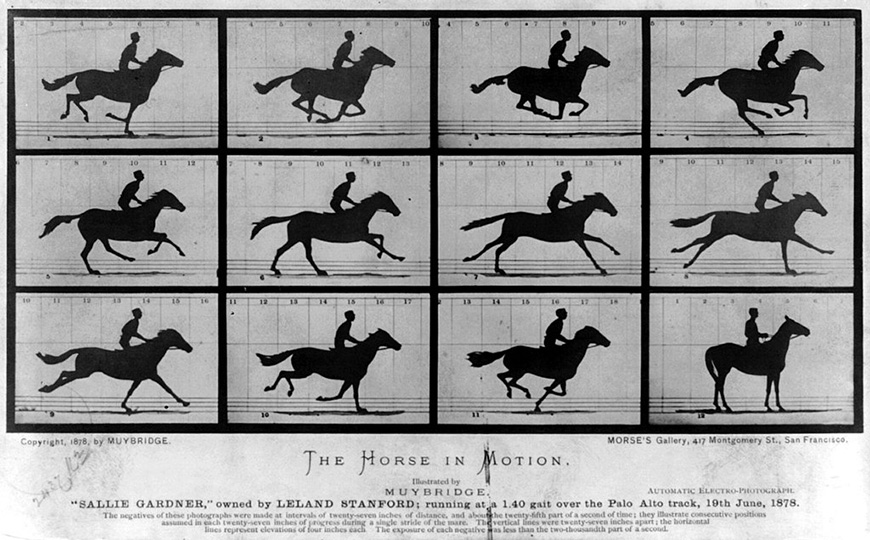
The Horse in Motion. Eadweard Muybridge, Public domain, via Wikimedia Commons
Eadweard Muybridge was an English-born photographer known for his groundbreaking work in motion photography.
Born in 1830, Muybridge’s photographic studies of motion and animal locomotion laid the foundation for the development of cinema and animation.
His famous series “Animal Locomotion” captured animals and humans in motion through a sequence of still photographs.
Muybridge’s experiments with high-speed photography and his use of multiple cameras revolutionized the understanding of movement and paved the way for the motion picture industry.
His contributions to the field of photography and his exploration of capturing movement make him a significant figure in photographic history.
Roger Fenton
Roger Fenton was an English photographer known for his pioneering work in the field of war photography.
Born in 1819, Fenton documented the Crimean War in the 1850s, capturing the soldiers, landscapes, and aftermath of the conflict.
His photographs provided a unique visual record of the war, becoming one of the earliest examples of photojournalism.
Fenton’s images brought the reality of war to the public’s attention, challenging the romanticized notions prevalent at the time.
His documentation of the Crimean War and his contributions to early war photography established him as a significant figure in the history of the medium.
Mark Fiennes
Mark Fiennes was a British photographer known for his contributions to theater and performance photography.
Born in 1933, Fiennes documented the world of theater, capturing the energy and dynamics of stage performances.
His photographs captured the essence of the actors and the atmosphere of live performances, showcasing his keen eye for composition and timing.
Fiennes’ work preserved the visual history of numerous theatrical productions, leaving a lasting impact on the documentation of the performing arts.
His dedication to capturing the magic and essence of theater through photography made him a respected figure in the field.
Don McCullin
View this post on Instagram
Don McCullin is a British photojournalist known for his powerful and haunting war photography.
Born in 1935, McCullin covered numerous conflicts and humanitarian crises around the world, including the Vietnam War, the Biafran War, and the Troubles in Northern Ireland.
His photographs captured the horrors of war, conveying the human suffering and the devastating consequences of armed conflicts.
McCullin’s images have played a crucial role in shaping public opinion and raising awareness about the realities of war.
His commitment to social justice and his ability to capture the raw emotions of his subjects make him a revered figure in the field of documentary photography.
Bill Brandt
Bill Brandt was a British photographer known for his powerful and evocative black-and-white images.
Born in Germany in 1904 and later settling in England, Brandt captured a wide range of subjects, including landscapes, portraits, and street scenes.
His unique use of light and shadow created dramatic and atmospheric compositions, often exploring the contrast between the rich and the poor.
Brandt’s notable works include his series “The English at Home” and “A Night in London,” which showcased his ability to capture the social realities of post-war Britain.
His distinctive vision and contributions to the field of photography have made him one of the most influential British photographers of the 20th century.
Michael Kenna
View this post on Instagram
Michael Kenna is a British photographer known for his serene and ethereal black-and-white landscapes.
Born in 1953, Kenna’s minimalist and poetic approach to photography has made him one of the leading landscape photographers of his generation.
His photographs often depict natural and man-made elements in a harmonious and meditative way, exploring the interplay between light, form, and texture.
Kenna’s iconic series include his images of serene Japanese gardens, mist-shrouded trees, and long-exposure seascapes.
His work has been exhibited worldwide and has been published in numerous books, reflecting his mastery of capturing the beauty and stillness of the natural world.
Julia Margaret Cameron
Julia Margaret Cameron was a British photographer known for her pioneering work in portrait photography during the Victorian era.
Born in 1815, Cameron’s portraits captured the inner spirit and emotional depth of her subjects, often featuring close-ups and evocative expressions.
Her images portrayed historical figures, literary icons, and her own family and friends, imbuing her photographs with a sense of intimacy and artistry.
Cameron’s soft-focus and intentionally blurry aesthetic diverged from the prevailing sharp-focus approach of the time, making her work distinct and innovative.
Her contributions to the medium of photography and her ability to convey a sense of vulnerability and humanity through her portraits continue to influence contemporary photographers.
Henry Fox Talbot
Henry Fox Talbot was a British scientist and pioneer in the field of photography, known for his invention of the calotype process.
Born in 1800, Talbot’s invention of the calotype, an early photographic process, played a vital role in the development of photography.
His calotype negatives allowed for multiple prints to be made from a single image, significantly advancing the accessibility and reproducibility of photographs.
Talbot’s extensive work covered a range of subjects, including landscapes, architecture, and botanical studies.
His contributions to the medium of photography and his scientific approach laid the foundation for future advancements in the field.
Tim Hetherington
Tim Hetherington was a British photojournalist and filmmaker known for his immersive and humanistic approach to documenting conflicts and social issues.
Born in 1970, Hetherington covered numerous war zones and humanitarian crises, including assignments in Liberia, Afghanistan, and Libya.
His photographs captured the humanity and resilience of people affected by war, shedding light on the human cost and the complexities of conflict.
Hetherington’s powerful documentary film “Restrepo,” which he co-directed, provided an intimate and immersive look into the experiences of American soldiers in Afghanistan.
His work was characterized by its empathy and deep understanding of the human condition, leaving a lasting impact on the field of photojournalism.
Felice Beato
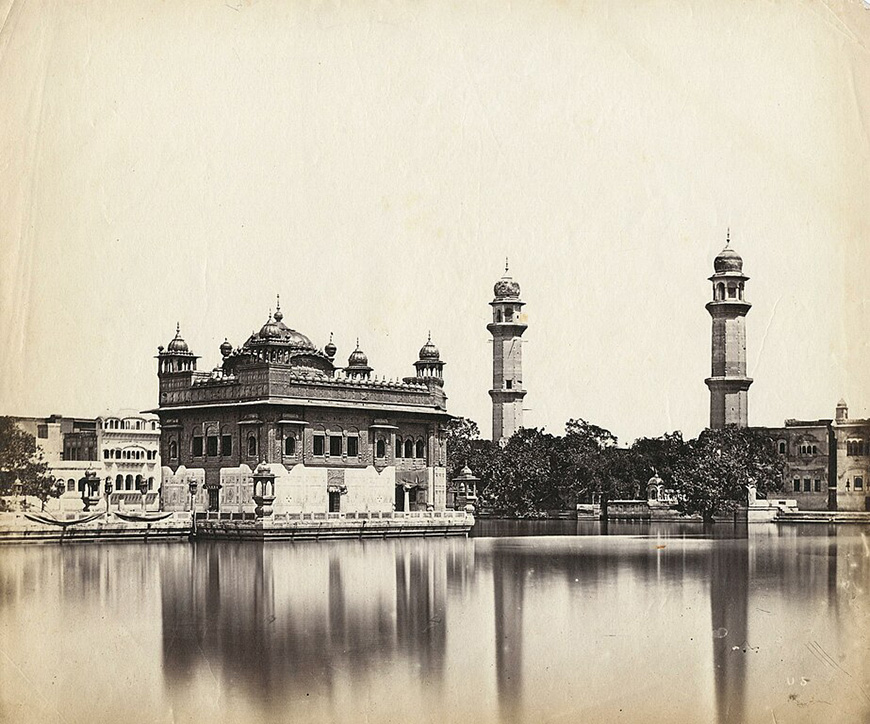
Photograph of the Golden Temple with the two watchtowers of Ramgharia Bunga in the background to the right, by Felice Beato, circa 1858–59, Public domain, via Wikimedia Commons
Felice Beato was an Italian-British photographer known for his pioneering work in war photography and documenting historical events.
Born in 1832, Beato traveled extensively throughout Asia and the Middle East, capturing significant moments in history.
His photographs of conflicts, such as the Crimean War, the Indian Rebellion of 1857, and the Second Opium War, provided a visual record of these events.
Beato’s images conveyed the devastation of war and presented a detailed and stark documentation of the people, places, and aftermath of conflicts.
His contributions to the field of war photography and his dedication to capturing historical events have had a lasting impact on the medium.
Nick Brandt
Nick Brandt is a British photographer known for his evocative black-and-white images of African wildlife.
Born in 1966, Brandt’s photographs capture the grandeur and vulnerability of Africa’s iconic animals in their natural habitats.
His powerful compositions and strong sense of empathy have brought attention to the need for wildlife conservation.
Brandt’s projects, including “On This Earth” and “A Shadow Falls,” have been widely exhibited and published in books, garnering international recognition.
His striking photographs serve as a reminder of the beauty and fragility of the natural world, urging viewers to appreciate and protect it.
Bert Hardy
Bert Hardy was a British photojournalist known for his powerful documentary photography and his coverage of World War II.
Born in 1913, Hardy worked for the influential magazine Picture Post, capturing the daily lives of ordinary people during the war and post-war years.
His photographs documented the resilience and spirit of the British people, as well as social issues and cultural shifts of the time.
Hardy’s iconic images, such as “The Tattooed Lady” and “Children in Southwark Slums.
Terence Donovan
Terence Donovan was a British photographer and filmmaker known for his influential contributions to fashion and portrait photography.
Born in 1936, Donovan emerged as one of the leading photographers of the Swinging Sixties in London.
His innovative and dynamic style, characterized by bold compositions and a sense of spontaneity, revolutionized fashion photography.
Donovan photographed renowned models and celebrities, leaving an indelible mark on the industry.
His work appeared in leading fashion magazines, and he collaborated with major fashion houses, contributing to the visual identity of the era.
George Rodger
George Rodger was a British photojournalist and co-founder of the Magnum Photos agency.
Born in 1908, Rodger covered significant historical events, including World War II and the Nuba tribe in Sudan.
His photographs captured the raw reality of war, as well as the diverse cultures and peoples he encountered during his travels.
Rodger’s iconic image of a liberated concentration camp survivor, taken during World War II, became a symbol of hope and resilience.
His commitment to documenting the human experience and his contributions to the field of photojournalism solidified his legacy.
William Friese-Greene
William Friese-Greene was a British inventor and early pioneer in the field of motion picture technology.
Born in 1855, Friese-Greene made significant contributions to the development of cinematography, experimenting with motion picture cameras and projection systems.
Although his inventions were not fully realized during his lifetime, his work laid the groundwork for subsequent advancements in film technology.
Friese-Greene’s passion and innovations in motion picture technology have had a lasting impact on the film industry, leading to the creation of the medium we know today.
Nikolai von Bismarck
View this post on Instagram
Nikolai von Bismarck is a British-German photographer known for his striking and intimate portraits of various personalities.
Von Bismarck’s photographs capture the essence and vulnerability of his subjects, whether they are celebrities, artists, or individuals from different walks of life.
His distinct style combines elements of traditional portraiture with a modern and edgy aesthetic, resulting in captivating and thought-provoking images.
Von Bismarck’s work has been featured in exhibitions and publications, showcasing his talent for capturing the complexity and depth of human emotions.
Oscar Gustave Rejlander
Oscar Gustave Rejlander was a British-Swedish photographer known for his innovative and complex composite images.
Born in 1813, Rejlander experimented with combining multiple negatives to create intricate and narrative photographs.
His masterpiece “The Two Ways of Life” is considered one of the first successful examples of a constructed photographic tableau.
Rejlander’s skill in manipulating and blending multiple images challenged the boundaries of photography as a medium for artistic expression.
His work has had a lasting influence on the development of composite and manipulated photography, paving the way for future advancements in the field.
Will Burrard-Lucas
Will Burrard-Lucas is a British wildlife photographer known for his innovative techniques and captivating images of wildlife in their natural habitats.
Burrard-Lucas has pioneered the use of remote-controlled cameras and camera traps to capture close-up and intimate shots of animals.
His photographs showcase the beauty and behavior of endangered species, bringing attention to the importance of wildlife conservation.
Burrard-Lucas’s dedication to capturing stunning wildlife images and his commitment to preserving the natural world have earned him recognition and acclaim in the field of wildlife photography.
Fay Godwin
Fay Godwin was a British photographer known for her captivating landscape images and her role as an environmental activist.
Born in 1931, Godwin’s photographs often depicted the British countryside, exploring the relationship between nature and human impact.
Her work raised awareness about environmental issues and the need for conservation, advocating for the preservation of natural landscapes.
Godwin’s black-and-white photographs captured the beauty and fragility of the land, evoking a sense of introspection and reverence.
Her images have been exhibited in galleries, published in books, and have become a significant part of the British photographic canon.
Pamella Bordes
Pamella Bordes is a British photographer and former model known for her provocative and controversial images.
Bordes’s photography explores themes of sexuality, gender, and societal norms, often pushing the boundaries of conventional representations.
Her bold and audacious images challenge traditional notions of beauty and femininity, inviting viewers to question and rethink their perceptions.
Bordes’s work has generated debate and sparked conversations about sexuality, empowerment, and the role of women in society.
Minnie Weisz
Minnie Weisz is a British photographer known for her architectural and urban photography.
Weisz’s photographs capture the beauty and intricate details of architectural spaces, exploring themes of space, light, and form.
Her images often reveal the interplay between the built environment and human presence, conveying a sense of narrative and emotion.
Weisz’s work has been exhibited in galleries and featured in architectural publications, showcasing her keen eye for composition and her ability to capture the essence of architectural spaces.
William Kennedy Dickson
William Kennedy Dickson was a British-American inventor and early pioneer in motion picture technology.
Born in 1860, Dickson worked closely with Thomas Edison and played a crucial role in the development of the Kinetoscope, an early motion picture exhibition device.
His innovations in film technology and his contributions to the development of the motion picture industry paved the way for future advancements in cinema.
Dickson’s legacy as a key figure in the history of motion pictures has earned him a significant place in the annals of film history.
David Noton
David Noton is a British landscape photographer known for his stunning images of natural and scenic landscapes.
Noton’s photography showcases his deep appreciation for the beauty of the natural world, capturing landscapes from around the globe.
His compositions are characterized by their clarity, depth, and sense of serenity, transporting viewers into breathtaking vistas.
Noton’s work has been widely published in books and magazines, and he has also led workshops and shared his expertise through his educational resources.
Chris Jagger
Chris Jagger is a British photographer and musician known for his photography capturing the world of rock and roll.
In addition to being a musician himself, Jagger has a keen eye for capturing candid moments and the energy of live performances.
His photographs of musicians and bands offer a behind-the-scenes glimpse into the rock and roll lifestyle, showcasing his ability to capture the essence and spirit of the music.
Jagger’s images capture the raw energy and emotion of the music scene, providing a visual documentation of the rock and roll culture.
Maxine Walker
Maxine Walker is a British photographer known for her expressive and emotive portrait photography.
Walker’s photographs capture the inner essence and emotional depth of her subjects, showcasing her ability to establish a connection with the individuals she photographs.
Her portraits often highlight the unique personality and vulnerability of her subjects, resulting in striking and intimate images.
Walker’s work has been exhibited internationally and has been recognized for its powerful storytelling and evocative imagery.
Pattie Boyd
Pattie Boyd is a British photographer and former model known for her iconic photographs of musicians and cultural figures.
Boyd’s photographs document the vibrant music scene of the 1960s and 1970s, capturing candid moments of artists such as The Beatles, Eric Clapton, and Jimi Hendrix.
Her intimate and personal photographs provide a glimpse into the lives of these legendary musicians and the cultural zeitgeist of the time.
Boyd’s work has been exhibited in galleries and published in books, offering a unique perspective on an era that continues to resonate with music lovers and enthusiasts.
Henry Peach Robinson
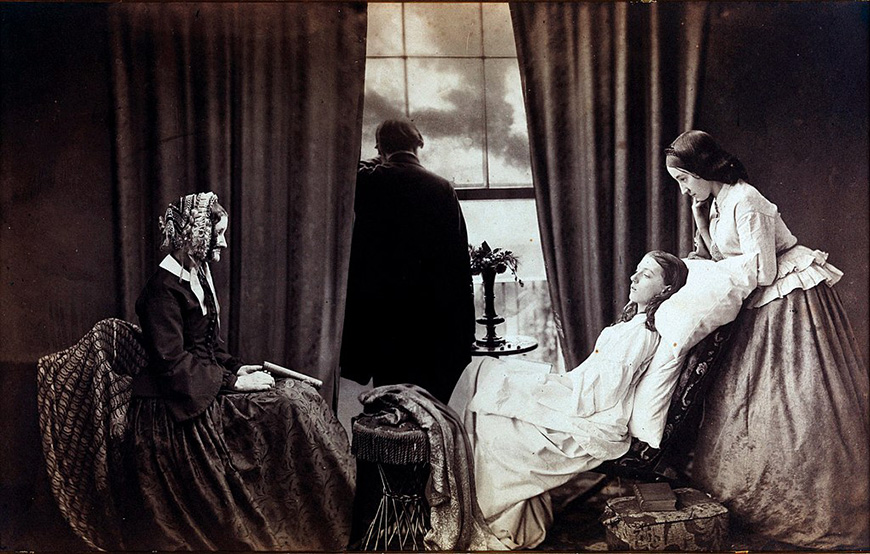
‘Fading Away’ by Henry Peach Robinson, Public domain, via Wikimedia Commons
Henry Peach Robinson was a British photographer known for his innovative composite images and contributions to pictorialism.
Born in 1830, Robinson’s photographs often combined multiple negatives to create narrative and atmospheric compositions.
His imaginative and painterly approach to photography challenged the notion of photography as a purely documentary medium.
Robinson’s work showcased his technical skill and artistic vision, influencing the development of the pictorialist movement.
His photographs, with their ethereal and poetic quality, left a lasting impact on the field of photography.
Allan Warren
Allan Warren is a British portrait photographer known for his iconic portraits of celebrities and cultural figures.
Warren’s photographs have captured the essence and personality of numerous notable individuals, including actors, musicians, and writers.
His portraits often convey a sense of intimacy and reveal the depth and complexity of his subjects.
Warren’s work has been exhibited worldwide and published in prominent publications, solidifying his reputation as a respected portrait photographer.
Frederick Rolfe
Frederick Rolfe, also known as Baron Corvo, was a British photographer, writer, and eccentric figure.
Born in 1860, Rolfe’s photographs often depicted scenes from his own life and travels, reflecting his unique perspective and artistic vision.
His photographs, alongside his literary works, offer a glimpse into the fascinating and enigmatic world of an unconventional artist.
Rolfe’s unconventional and often controversial life has earned him a place in the annals of British artistic history.
Vanley Burke
Vanley Burke is a British photographer known for his documentation of the Black British experience and the Caribbean diaspora in the United Kingdom.
Born in Jamaica, Burke moved to Birmingham, England, in 1965 and began documenting the lives of the local Black community.
His photographs capture the resilience, cultural heritage, and struggles of the Black community, addressing themes of identity, migration, and social inequality.
Burke’s work has been exhibited in galleries and museums, providing a powerful visual narrative of the Black British experience.
Terry O’Neill
Terry O’Neill was a British photographer known for his iconic images of celebrities and cultural figures.
Born in 1938, O’Neill captured the essence and charisma of numerous renowned personalities, including musicians, actors, and political figures.
His photographs have become synonymous with the Swinging Sixties and the glamour of Hollywood, providing an intimate and behind-the-scenes look at the world of fame.
O’Neill’s images have graced the covers of magazines, adorned gallery walls, and have become a testament to his talent for capturing the spirit of his subjects.
Nigel Barker
Nigel Barker is a British fashion photographer and television personality known for his work in the fashion industry.
Barker gained prominence as a judge and photographer on the reality TV show “America’s Next Top Model.”
His fashion photography captures beauty and style, showcasing his ability to create striking and memorable images.
Barker’s work has been featured in fashion magazines, and he has collaborated with renowned designers and brands.
His contribution to the fashion industry and his distinctive style have solidified his place as a respected and influential fashion photographer.
What are some Common Styles adopted by British Photographers?
British photographers have embraced various styles throughout the history of photography. Some common styles adopted by British photographers include:
- Pictorialism: Pictorialism refers to a style that emphasizes the artistic qualities of photography, often blurring the lines between photography and other art forms. UK photographers such as Henry Peach Robinson and Julia Margaret Cameron were known for their pictorialist approach, employing soft focus, elaborate compositions, and manipulating their images to create painterly and atmospheric photographs.
- Documentary Photography: Photographers from the United Kingdom have made significant contributions to the field of documentary photography. This style focuses on capturing real-life events, social issues, and the everyday lives of people. Notable British documentary photographers include Roger Fenton, known for his coverage of the Crimean War, and Martin Parr, who documents British culture and society with a satirical and observational approach.
- Fashion Photography: Britain has a rich history in fashion photography. British photographers like Cecil Beaton, David Bailey, and Tim Walker have made significant contributions to the field. They have showcased their unique styles in capturing fashion and beauty, often combining artistic and commercial elements to create visually striking and influential images.
- Portraiture: British photographers have excelled in portraiture, capturing the essence of individuals, celebrities, and cultural figures. They often explore the psychological and emotional depths of their subjects, creating intimate and powerful portraits. Notable British portrait photographers include Terry O’Neill, who has photographed numerous iconic figures, and Rankin, known for his bold and edgy approach to portraiture.
- Street Photography: British photographers have a long-standing tradition of street photography, documenting the everyday life and urban landscapes. They capture candid and unposed moments, reflecting the diverse and dynamic nature of British society. Henri Cartier-Bresson, though French, was influential in shaping British street photography with his concept of “the decisive moment.
- Landscape Photography: The British landscape has been a source of inspiration for photographers throughout history. British landscape photographers capture the beauty and diversity of the natural environment, often showcasing the dramatic and picturesque scenery of the British Isles. Notable landscape photographers include Fay Godwin, who focused on the relationship between humans and the land, and Michael Kenna, known for his minimalist and ethereal black-and-white landscapes.
As the Content Manager of Shotkit, India Mantle brings with her a lifelong love for photography that she developed during her childhood, watching her father document their family moments with his Nikon EM. In her free time, you find her enjoying the awe-inspiring natural beauty of her home, Northern Rivers, Australia.






